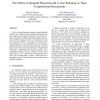Free Online Productivity Tools
i2Speak
i2Symbol
i2OCR
iTex2Img
iWeb2Print
iWeb2Shot
i2Type
iPdf2Split
iPdf2Merge
i2Bopomofo
i2Arabic
i2Style
i2Image
i2PDF
iLatex2Rtf
Sci2ools
FCCM
2002
IEEE
2002
IEEE
The Effects of Datapath Placement and C-Slow Retiming on Three Computational Benchmarks
C-slow retiming (changing a design to support multiple instances of a computation) and datapath-aware placement have long been advocated by members of the FPGA synthesis community as highly useful and profitable optimizations for FPGA designs, but have yet to find their way into the commercial toolflows. To quantify the significance of these techniques on real world applications, we have handimplemented three computational benchmarks which are taken directly from real world applications: Rijndael/AES encryption, a Smith/Waterman sequence matcher, and a simplified Microprocessor core, targeted to Xilinx Virtex family FPGAs. The combined use of datapath placement and C-slow retiming offer a 110% to 150% increase in throughput, improves place and route times, while increasing area and latency.
| Added | 14 Jul 2010 |
| Updated | 14 Jul 2010 |
| Type | Conference |
| Year | 2002 |
| Where | FCCM |
| Authors | Nicholas Weaver, John Wawrzynek |
Comments (0)

